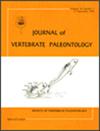A saw-toothed eel † Serrivomer glehni sp. nov. from the Miocene of Sakhalin Island, north-western PacificCitation for this article: Nazarkin, M. V. (2023) A saw-toothed eel † Serrivomer glehni sp. nov. from the Miocene of Sakhalin Island, north-western Pacific. Journal of Vertebrate Paleontology . https://doi.org/10.1080/02724634.2023.2261505
IF 1.9
4区 地球科学
Q2 PALEONTOLOGY
引用次数: 0
Abstract
ABSTRACT†Serrivomer glehni, a new species of the Neogene saw-toothed eel (Anguilliformes, Serrivomeridae) is described based on the 55 specimens from the Middle–Upper Miocene Kurasi Formation of Sakhalin Island, Russia. This is the third record of fossil saw-toothed eels since the recovery of partial skeletons from the Miocene of Japan and Italy. The new species demonstrates close similarity to the extant Serrivomer species in overall body form and shape of separate bones and their complexes. The new species is characterized by the “longidentatus” type of vomerine dentition and by a single branchiostegal ray protruding beyond the hyoid bar, which suggests a close affinity to the modern S. sector. It can be reliably distinguished from all other species of Serrivomer by its lower number of vertebrae (134 vs. 140–172) and its larger cleithrum, which is positioned under the seventh instead of the eighth vertebral centrum.http://zoobank.org/urn:lsid:zoobank.org:pub:50673E06-602C-4CA1-8CFF-AD992BCAEBED ACKNOWLEDGMENTSI am grateful to A. I. Pinchuk (University of Alaska) for his great help with the English. Special thanks go to A. M. Prokofiev (A.N. Severtsov's Institute of Ecology and Evolution, Russian Academy of Sciences, Moscow, Russia) for donation of comparative materials. I thank the editors, along with anonymous reviewers for their valuable comments and corrections to the manuscript. The reported study was funded by the Russian Government Research Theme No. 122031100285-3.AUTHOR CONTRIBUTIONSThe author confirms sole responsibility for the study concept, data collection, analysis and interpretation of results, and preparation of the manuscript.DISCLOSURE STATEMENTNo potential conflict of interest was declared by the author.A saw-toothed鳝†Serrivomer glehni sp. nov. from中新世的库页岛,西北太平洋。古脊椎动物杂志。https://doi.org/10.1080/02724634.2023.2261505
摘要/ ABSTRACT摘要:本文根据俄罗斯库页岛中新世中上统Kurasi组55份标本,描述了新近系锯齿鳗(鳗形目,锯齿鳗科)的一新种Serrivomer glehni。这是自日本和意大利中新世发现部分锯齿鳗鱼骨骼以来,第三次发现锯齿鳗鱼化石。新种与现存的serriomer物种在整体形态和独立骨骼及其复合体的形状上表现出非常接近的相似性。这个新物种的特征是长齿状牙列和一条突出在舌骨棒之外的鳃骨射线,这表明它与现代的s系有密切的关系。由于它的椎骨数量较少(134对140-172),其更大的椎骨位于第七椎体而不是第八椎体之下,因此可以可靠地将其与所有其他种类的Serrivomer区分出来。http://zoobank.org/urn:lsid:zoobank.org:pub:50673E06-602C-4CA1-8CFF-AD992BCAEBED感谢A. I. Pinchuk(阿拉斯加大学)在英语方面的巨大帮助。特别感谢A. M. Prokofiev (A. n . Severtsov的生态与进化研究所,俄罗斯科学院,莫斯科)捐赠的比较材料。我感谢编辑,以及匿名审稿人对手稿的宝贵意见和更正。报告的研究由俄罗斯政府研究主题No. 122031100285-3资助。作者确认对研究概念、数据收集、结果分析和解释以及稿件的准备负全部责任。声明作者未声明存在潜在的利益冲突。
本文章由计算机程序翻译,如有差异,请以英文原文为准。
求助全文
约1分钟内获得全文
求助全文
来源期刊
CiteScore
2.90
自引率
7.10%
发文量
58
审稿时长
4-8 weeks
期刊介绍:
The Journal of Vertebrate Paleontology publishes original contributions on all aspects of vertebrate paleobiology, including vertebrate origins, evolution, functional morphology, taxonomy, biostratigraphy, phylogenetics, paleoecology, paleobiogeography, and paleoanthropology. JVP publishes high quality peer-reviewed original articles, occasional reviews, and interdisciplinary papers. It is international in scope, and emphasizes both specimen- and field-based based research and the use of high-quality illustrations. Priority is given to articles dealing with topics of broad interest to the entire vertebrate paleontology community and to high-impact specialist studies. Articles dealing with narrower topics, including notes on taxonomic name changes (unless these deal with errors published in JVP), preliminary site reports, and documentation of new specimens of well-known taxa, are afforded lower priority.

 求助内容:
求助内容: 应助结果提醒方式:
应助结果提醒方式:


